
Transforming Customer Data into Actionable KPIs: A Real-Time Approach
November 18, 2024
The Thanksgiving Edition with Gabby Blados
November 22, 2024Who Believes What? A Demographic Breakdown of Conspiracy Theories
Introduction
Conspiracy theories are everywhere, from conversations about technology to debates over government control. This data, collected by EMI, provides a fascinating look at which theories resonate most across different demographics and why. By asking respondents to rate their belief on a 5-point scale, we’ve uncovered the ideas shaping today’s modern anxieties—and how factors like age, gender, and ethnicity influence the spread of these beliefs. Understanding these trends helps EMI provide actionable insights into societal trust, skepticism, and the impact of narratives on public opinion.
Context
Respondents rated their belief in various conspiracy theories on a 5-point scale, including an “unfamiliar” option for those unaware of specific theories. The percentages reflect respondents who selected the top two boxes, representing those who strongly or somewhat believe in each conspiracy. From concerns about government control to technological paranoia, the data highlights both the breadth and depth of belief in conspiracy theories today.
General
Conspiracy theories are all over the place, but one takes the crown: 41% of people think their phones are always listening to them. This tech paranoia crushes the competition.
Coming in next, 26% believe a “Deep State” runs the U.S. government, and 23% are convinced NFL games are rigged for money or drama. On the flip side, fewer people are buying into older or more niche ideas—20% think the government controls the weather, and just 18% believe the U.S. faked the moon landing.
From secret plots to tech fears, it’s clear modern anxieties are shaping which conspiracies people latch onto today.

Gender
Belief in conspiracy theories looks very different depending on gender. Men are consistently more likely to lean into these theories than women, often by significant margins.
For example, 23% of men think the U.S. faked the moon landing, compared to just 13% of women. Similarly, 32% of men believe a “Deep State” controls the government, versus 21% of women, and 28% of men think NFL games are rigged, compared to 19% of women. Even when it comes to weather manipulation, men (24%) outpace women (17%).
The one exception? Belief that cell phones are always listening, where men and women are nearly tied at 41% and 40%, respectively. This suggests some conspiracies cut across gender, but others clearly resonate more with men.
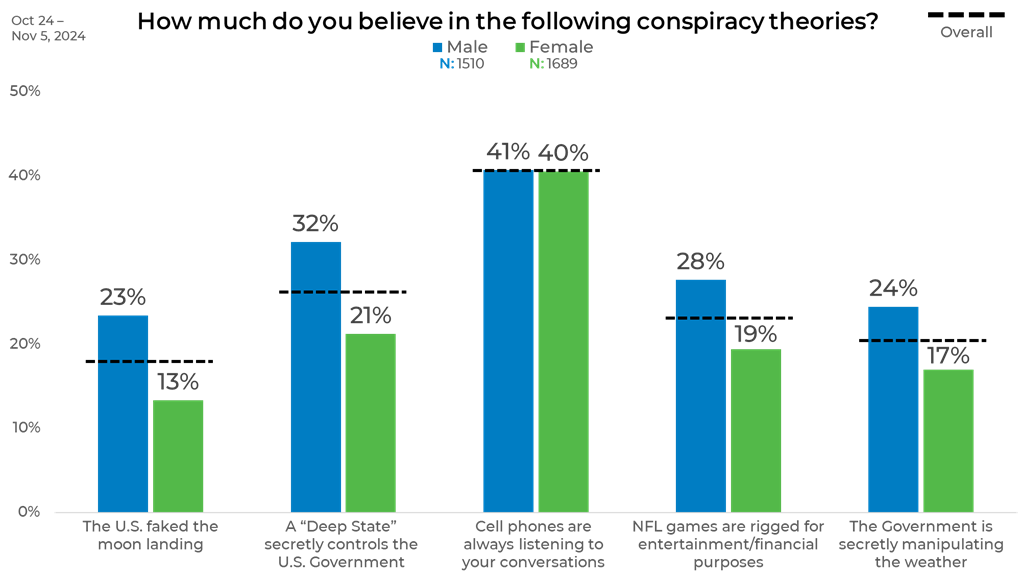
Political Affiliation
Political leanings seem to shape belief in conspiracy theories, with some notable differences between groups. Republicans are the most likely to believe in a “Deep State” secretly controlling the government (35%), compared to 21% of Democrats and 25% of Independents.
When it comes to the idea that cell phones are always listening, there’s broader agreement: 45% of Republicans, 38% of Democrats, and 40% of Independents buy into this one. The same is true for the theory that the U.S. faked the moon landing, where belief stays steady across the board at 16–19% regardless of party.
For theories like NFL games being rigged and government weather manipulation, Republicans are slightly more likely to believe than Democrats, but the gap isn’t as stark. Overall, tech suspicions and secretive government plots seem to unite more than divide across political lines.
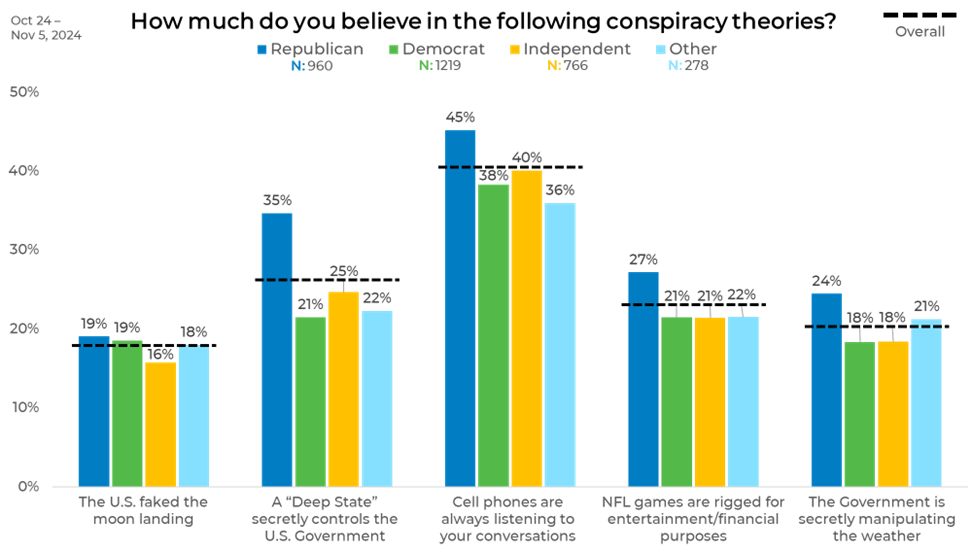
Age
Belief in conspiracy theories takes a dramatic turn depending on age, with younger generations far more likely to buy into them than older ones. For instance, 51% of 18-24-year-olds think cell phones are always listening, compared to just 15% of those 65 and older. Similarly, the idea that NFL games are rigged resonates with 32–33% of 18-44-year-olds, but only 7% of seniors.
The pattern continues across theories: 27% of 25-34-year-olds believe the U.S. faked the moon landing, versus just 5% of seniors. Even the concept of a “Deep State” running the government peaks at 33% among 35-44-year-olds, dropping to 17% for the 65+ crowd.
This data highlights a striking generational divide, with younger people more inclined to question institutions, technology, and mainstream narratives, while skepticism fades significantly with age.
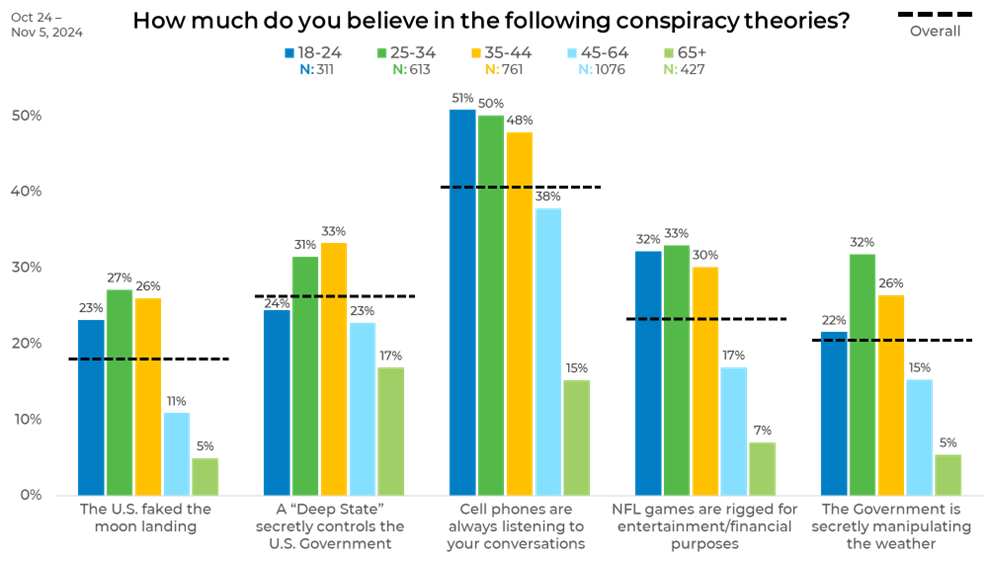
Ethnicity
Belief in conspiracy theories shows clear differences across ethnic groups, with African-American and Hispanic/Latino respondents consistently reporting higher levels of belief compared to Caucasian or Asian respondents. For example, 50% of African-Americans and Hispanics believe cell phones are always listening, compared to 38% of Caucasians and 31% of Asians.
Theories like the U.S. faking the moon landing and the government manipulating the weather see a similar trend. 30% of African-Americans and 26% of Hispanics think the government manipulates the weather, compared to just 17% of Caucasians and 13% of Asians. Belief in a “Deep State” secretly controlling the government is also higher among African-Americans (32%), Hispanics (31%), and those identifying as “Other” (34%), compared to 24% of Caucasians and 16% of Asians.
The data suggests that trust in government and institutions may vary significantly by ethnicity, influencing how different groups respond to conspiracy theories.
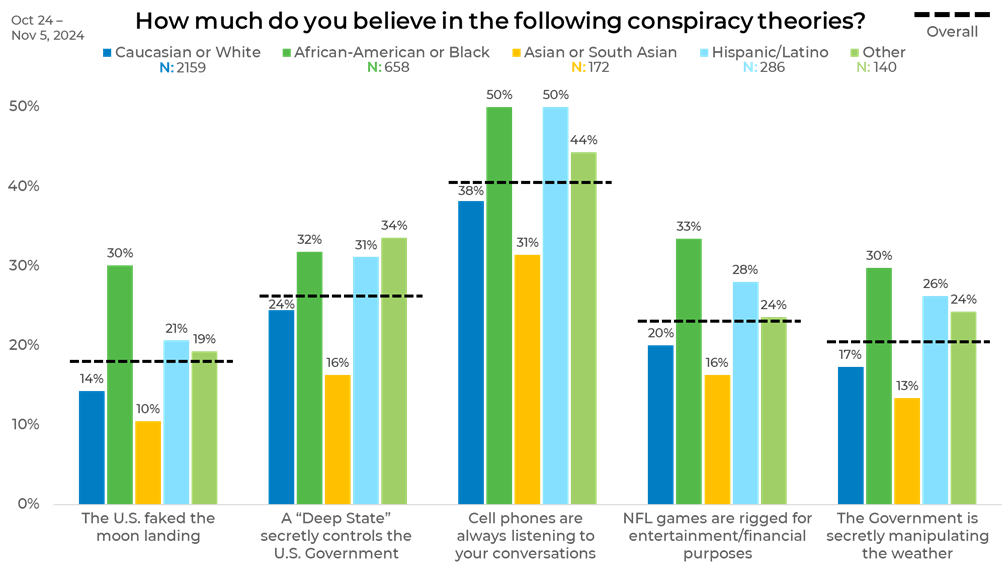
Panels
Belief in conspiracy theories varies widely across panels, with Panel I consistently reporting the highest levels of belief. For example, 48% of Panel I think cell phones are always listening, compared to 35% in Panel A and 36% in Panel M. Similarly, 28% of Panel I believe the government manipulates the weather, while Panels A and O are far less convinced at 12% and 18%, respectively.
Panel E also stands out, especially with 34% believing in a “Deep State” controlling the government and 28% thinking NFL games are rigged, putting it closer to Panel I’s higher levels of belief. In contrast, Panel A is consistently the most skeptical, with the lowest belief levels across the board—for example, only 8% think the moon landing was faked.
The stark contrasts between panels highlight how attitudes toward conspiracy theories can differ dramatically, even within the same dataset, reflecting unique perspectives or demographics within each group.
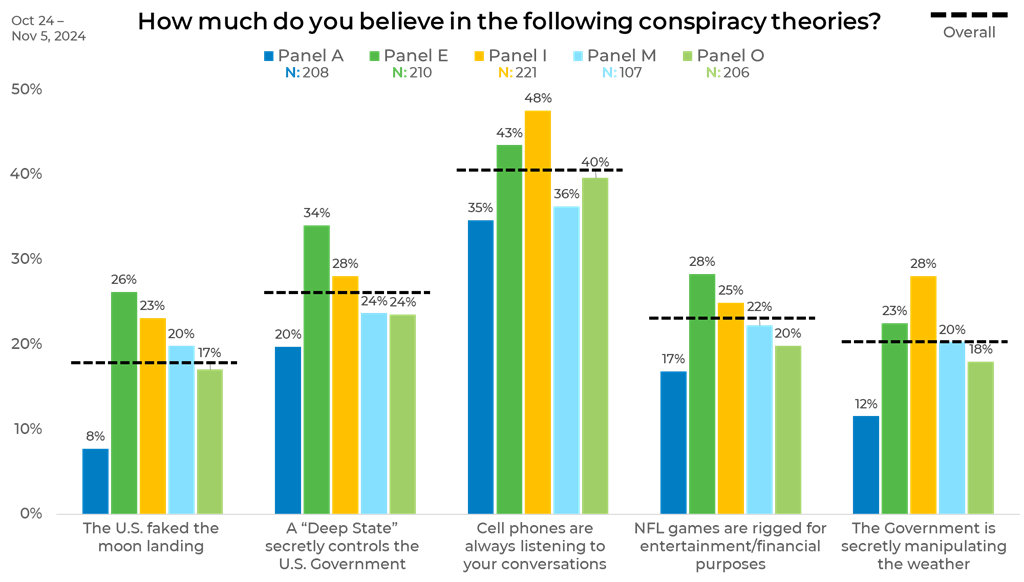
Conspiracy theories are not always just fringe ideas—they reflect broader societal concerns, shaped by factors like age, gender, and ethnicity. At EMI, we know that understanding these beliefs can be critical to delivering accurate, actionable insights. Whether it’s tech paranoia or mistrust in government, conspiracy theories provide a lens into the narratives shaping public opinion today.
By leveraging high-quality data sampling, EMI ensures that these insights represent the diverse perspectives of the population, empowering better decision-making across industries. Learn more about what sets us apart from the rest of the industry.



